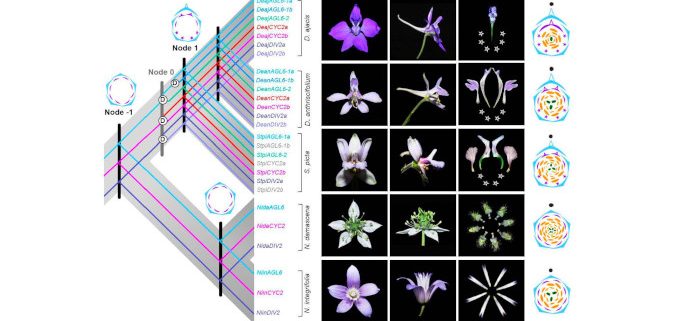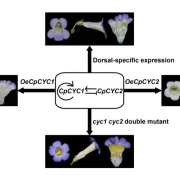New tricks for old dogs: The making of complex flowers in Delphinieae
Zhao et al. examine the genetic basis of complex flowers.
Huiqi Zhao(a,b,d), Hong Liaoa, Shuixian Lia(b,c), Rui Zhang(a,e), Hongzhi Konga(b,c), Hongyan Shana(c)
a State Key Laboratory of Systematic and Evolutionary Botany, CAS Center for Excellence in Molecular Plant Sciences, Institute of Botany, Chinese Academy of Sciences, Beijing 100093, China
b University of Chinese Academy of Sciences, Beijing 100049, China
c China National Botanical Garden, Beijing 100093, China
d Hainan Academy of Agricultural Sciences, Haikou 571100, China
e Northwest A&F University, Yangling, Shaanxi, 712100, China
Background: Flowers can be simple or complex if their structures and symmetries, as well as the shapes, types, numbers, fusion, and arrangements of their constituent parts are considered. While models for floral organ identity specification and flower symmetry determination laid the foundation for understanding the developmental mechanisms of diverse flowers, how complex flowers are made via development and evolution remains largely unclear. Members of the tribe Delphinieae (Ranunculaceae) bear highly specialized, nearly zygomorphic (bilaterally symmetrical) spiral flowers with nested petal and sepal spurs and reduced petals, making them excellent systems for studying the mechanisms underlying the making of complex flowers.
Question: How are Delphinieae flowers generated via development and evolution? Did floral organ identity genes and floral symmetry genes also play key roles during the evolution of highly complex Delphinieae flowers? Did the two key morphological innovations, zygomorphy and spurs, originate concurrently or successively?
Findings: By conducting extensive phylogenetic, comparative transcriptomic, expression, and functional studies, we revealed that duplication and/or diversification of AP3-3, AGL6, CYC and DIV lineage genes was tightly associated with the origination of Delphinieae flowers. Compared to the outgroup Nigelleae, one of the AGL6-lineage members, AGL6-1a, and two CYC2-like genes, CYC2a and CYC2b, have gained new functions in specifying floral zygomorphy in Delphinieae. More intriguingly, regulatory links were found between CYC2b and AP3-3 and among CYC2a, AGL6-1a and DIV1. Altogether, these findings suggest that duplication and diversification of floral symmetry genes, as well as co-option of the duplicated copies into the pre-existing floral regulatory network, may have been the reasons for the origin of the Delphinieae-type flowers.
Next steps: We will seek to determine how sepal and petal spurs originated in Delphinieae and how complex flowers in other plant lineages formed via development and evolution.
Reference:
Huiqi Zhao, Hong Liao, Shuixian Li, Rui Zhang, Jing Dai, Pengrui Ma, Tianpeng Wang, Meimei Wang, Yi Yuan, Xuehao Fu, Jie Cheng, Xiaoshan Duan, Yanru Xie, Peng Zhang, Hongzhi Kong, Hongyan Shan (2023) Delphinieae flowers originated from the rewiring of interactions between duplicated and diversified floral organ identity and symmetry genes. https://doi.org/10.1093/plcell/koac368





